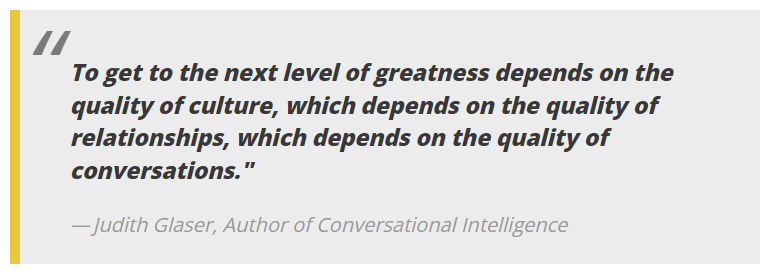I hate small talk.
I used to think that. Used to say it out loud. And I have clients who say this to me all the time.
I hate to make small talk.
We understand this, right? I don’t like to waste my time. We have so much important stuff to talk about. We have a very packed agenda. Why spend time, well, talking about frivolous things?
And yet, the expectation in any business conversation these days is that we start with a bit of small talk. We don’t leap into any meeting – virtual, in-person - with Agenda item #1 right away. We warm up. We ease in. And now that you’re back in the office, once in a while – there’s the hallway chat. The elevator chat.
Small talk. The phrase itself sounds pejorative, doesn’t it? Trivial. Irrelevant. Small. Doesn’t matter.
It’s a byproduct of a cultural lens that believes all time needs to be used productively. That the nonproductive use of time is wasted time. There are other cultural lenses, of course. These lenses are dominant in large swaths of the world. They value social pleasantry and conversation over efficient agenda-run-throughs. That affirm that we won’t get to step 2 without hanging out in step 1.
Step 1 being small talk.

Time to up-end some of our notions of small talk, don’t you think? Let’s consider 3 conversational delineations as outlined by the renowned Judith Glaser, author of “Conversational Intelligence: How Great Leaders Build Trust & Get Extraordinary Results.”
Level I: Transactional Conversations.
We exchange information, updates, and facts that help us align our realities or confirm that we are on the same page. There is not a lot of trust, and we focus more on what we need to get from each other.
Level II: Positional Conversations.
What is this about, really? I can have a tough conversation with a colleague who matters little to me but fear having it with a friend? A difficult chat with a friend creates greater discomfort even though I have a relationship that supposedly involves shared history, honesty and trust?
Level III: Transformational Conversations.
Marked by “Share and Discover” dynamics. When I share first, my brain receives a cue that I will be vulnerable with you and that I will open up my inner thoughts, ideas, and feelings. You receive the signal that I will be open to your thoughts, ideas, emotions.
Small Talk, at its very best, is neither transactional nor positional. It is a Level III Conversation. It has the potential to be the highest, or deepest, way of engaging with another human.
Because our conversation can go absolutely anywhere.
Let’s look at how most virtual business conversations start. Zoom, Google Meetings, or Webex link up with each other. A video screen pops up. More often than not, the other person is fiddling with their audio. And then, of a sudden, we’re audio- and video-connected.
And we dive into Small Talk. Consider the following prototypes of what is likely to happen in the first 60 seconds of small talk.
We Declare "How We're Doing."
It's totally automatic, isn't it? Without much thought, we ask How are you doing? or How's it going? More often than not, we turn this question and subsequent answer into a platitude that means nothing. We make it truly small. We choose to hide. Don't. Why not be truthful?
The judgment I make is that no one wants to truly know how I'm doing today. The other person has made the same judgment. What is really going on and how we really feel - frustrated, exhilarated, tired, energized, overwhelmed - is not to be mentioned. We keep the lid to a more honest revelation tightly shut. Why? What could be an exchange of empathy or shared experience is never allowed to happen. Allow it.
We Notice the Moment.
The video turns on, and you may find your conversation partner in an unusual setting. You may be in a setting the other person has never seen. You may spot an unusual object, a surprising artifact in the frame. Your colleague may look different to you just because the lighting in that very moment is different. That's fodder for conversation. Because it's staring at you and screaming, acknowledge me.
I was chatting about these little observations with Jeannie, a client. Jeannie described a moment when she facilitated a sales meeting with her global team, and she noticed that Phil from the UK was wearing a really funny sweater. "I wanted to comment on the sweater," Jeannie says to me, "but then I decided not to. I thought that might be too personal." Why, I thought to myself? If Phil wears a funny sweater he wants you to notice the sweater. It's almost rude to not acknowledge the sweater. What marvelous stories may be lurking behind that sweater?
We Widen the Context
There is so much going on in everyone's immediate world, every day. What's going on need not necessarily be talked about. Understood. But why not at least open the possibility of "going there?" Instead of asking How are you doing?, consider asking How are things in Hollywood? A wider frame. If I want to walk through the Hollywood door with you (that is where I reside), we suddenly have a richer and more nuanced start to our conversation.
I began a call with my client Steve the other day with "How are things in Phoenix?" Steve responded by sharing his frustrations with the noise of new construction happening on his block. This allowed me to tell Steve about the new development going on in my part of Hollywood, and my involvements as the Board member of my neighborhood civic association. My question prompted a richly personal start to our conversation. This start, of course, elevated the entire rest of the conversation!
Don’t just talk about nothing. Talk about something.
Small talk = human connection. Or, to be clear, the opportunity for human connection. Why would we squander that opportunity?
Judith Glaser got this right. Transformational conversations are the richest and most potent conversations that we can have with another human. They are marked by a "share and discover" dynamic. And that's what happens in conscious Small Talk.
So please, let us discover. Small Talk, anyone?
Related: The Case for Less Vulnerability


